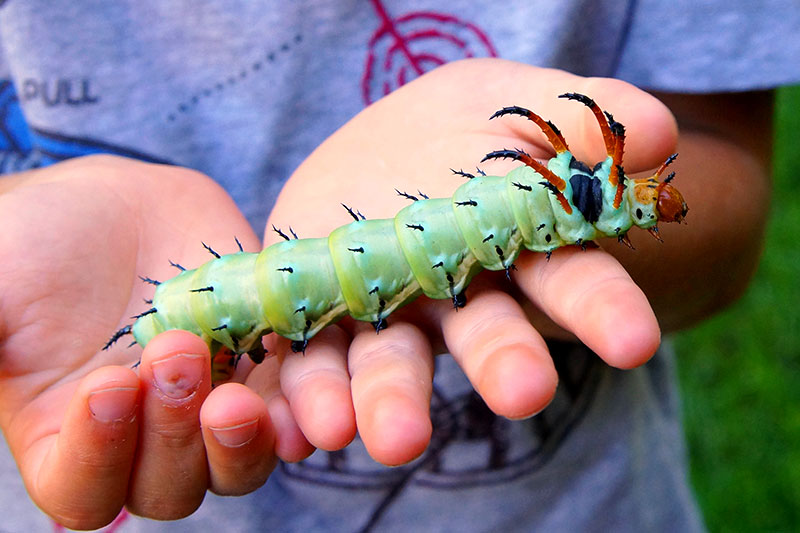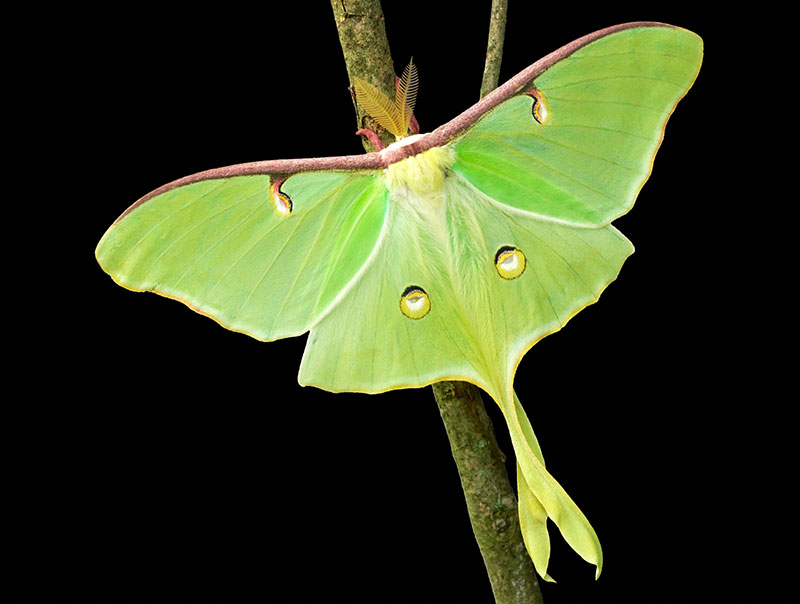
What’s so great about great big moths? When we encounter them, we take notice. It’s not just another flittery fragile thing drawn to our lights, or, in their caterpillar phase, not just another little unremarkable inchworm scooting along a leaf. Wild silk moths are the creatures of the night that make you gasp and wonder what is that? Whether it’s stinging hairs of barbed Io moth caterpillars (pictured below) or glaring eyespots on a polyphemus moth’s outstretched wings, these animals want to get noticed.
North American silk moths are distinct from silkworms (Bombyx mori), which are commercially raised for the silk harvested from their cocoons. They are classified in the same family tree, but the North American moths have not been bred in captivity. There are approximately 100 giant silk moth species in North America with wingspans that range from 1 to 7 inches, making them the largest moths on this side of the world.
The caterpillar phase is the only time of their life cycle that silk moths can eat, and they must eat enough to fuel their winter-long metamorphosis, like a bear stocking up to hibernate. But caterpillars must stockpile calories in their wiggly little bodies to fuel them well into the next phase of life. As winged creatures, the sole mission of their flights is to mate and lay eggs. That puts a lot of pressure on them to eat up as much as they can while they have mouthparts to do so.
Wild silk moths live all across North America and are concentrated heavily in eastern forests and, surprisingly, the arid west as well. Their diets are as varied as the landscape, and their names help identify what plants they depend on. In the Four Corners area of the Southwest, the range caterpillar moth eats grasses of the open range, such as grama grass, buffalo grass and Texas timothy. Eastern white pines are home to the pine-devil moth, which lays eggs at the base of pine needles. Deciduous trees could host many other types of silk moth caterpillars, such as tuliptree silkmoth, which lives in a magnolia by the name of tulip poplar. One of the most fierce-looking caterpillars, the hickory horned devil (shown below), is also known as the royal walnut moth. Hickory and walnut trees are among their hosts.
Wild silk moth cocoons are not easy to find and forage in order to make fiber from their strands. Many species spin their cocoons in fallen leaf litter, while others, including the Hubbard’s small silkmoth, simply burrow into the ground to overwinter and metamorphose. The tuliptree silkmoth is well camouflaged as a magnolia leaf that falls to the ground with the cocoon wrapped within, and the cecropia caterpillar (the adult version is shown below) hides its little hammock behind leaves of wild cherry, plum or sugar maple.
Adult giant silk moths resemble mammals. Their antennae appear furry, as do the legs and bodies of many species. Those feathery-edged antennae serve as the all-important pheromone detectors for finding a mate. Also, moth antennae are navigation devices that keep the insects balanced and oriented so they can fly through the night without collisions.

Which ones might you see flying? With a wingspan of four to seven inches, the queen of all silkmoths must be the luna moth (shown above), named for the Roman moon goddess. Elusive, strong fliers, luna moths depend on a variety of eastern forest trees such as hickories, sweetgum, birch, walnuts and persimmon. They aren’t rare as a species, but they are rarely seen because they live only about a week in their adult phase. Orange-tipped oakworm moths are unusual for moths because they fly during the day. There are far more moth caterpillars munching away on the leaves of trees, grasses and shrubs, and they provide easy pickings for birds feeding their young. The North American silk moths that survive to adulthood have earned the right to spread their big, bold wings, show off and get noticed for their wild beauty.




